



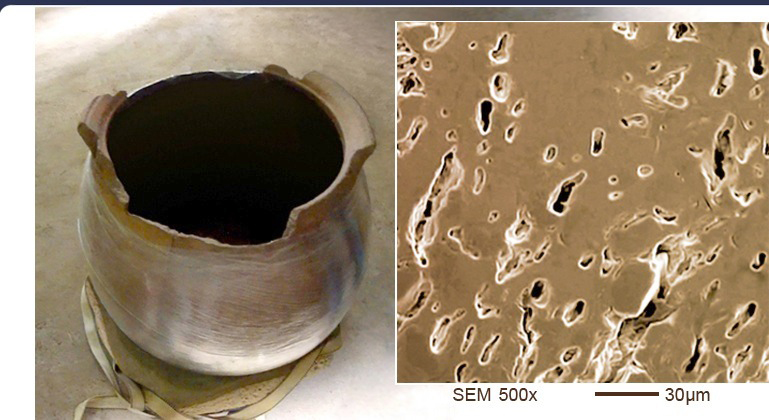
Resonance in The Pyramids of La Maná, Ecuador
Megaceramic Jars of the La Maná Pyramids are Semiconductor Onggi
by Alex Putney for Human-Resonance.org
May 15, 2015
During the course of our surface soil investigations and trench excavations in 2014 at the Hummingbird Pyramid in La Maná, Ecuador, several dozen very thick pot sherds were recovered that once belonged to immense earthenware jars that are best described as 'megaceramics'.
Fine examples of ancient Ohum megaceramics have also been discovered during residential construction projects and mound excavations undertaken by La Maná area landowners. One such find represents a giant, partly fragmented earthenware fermentation jar (seen below before repair, wrapped with protective cellophane). The original domed lid was also collected during excavation, fragmented into 46 sherds.
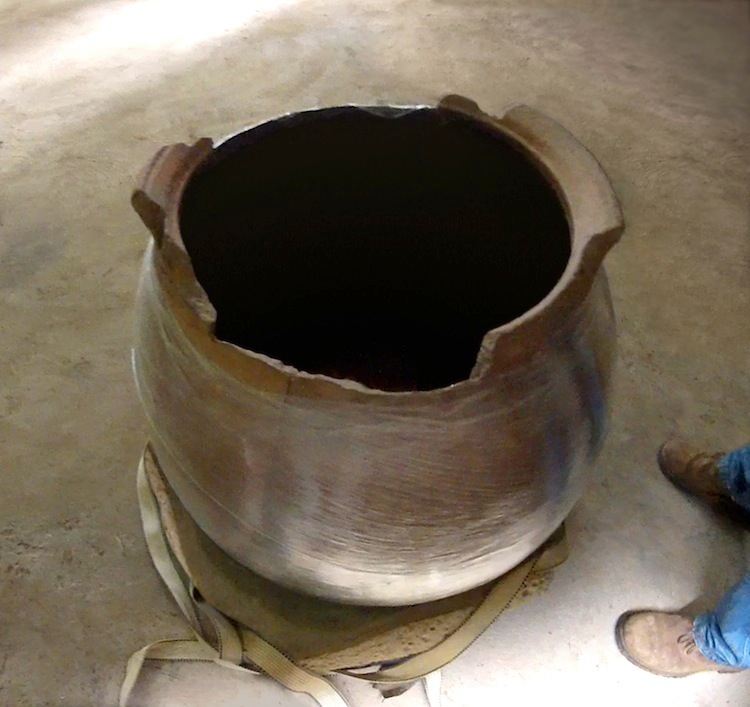
This robust type of megaceramic fermentation jar displays a perfectly hemispherical bottom --and no shoulder text inscriptions-- because the vessel was designed for half-burial during use, with a very wide neck and thick rim to accommodate the large domed lid. Five small fragments from the damaged rim sections were recovered and reintegrated with the giant jar during the delicate repair process.
The giant food preservation jar's initial weight was measured at 44kg before conservatory repairs were made, raising its total weight to 47kg. The jar stands 63cm tall, with a maximum diameter of 74cm and maximum circumference of 210cm. Its broad rim measures 52mm in width and 40mm in height, presenting a matte orange glaze coating and a total outer diameter of 52.2cm. The immense proportions and weight of this fermentation vessel are exceeded by others preserved in the region's caves and burial mounds.
The dome-shaped earthenware lid has also been fully reconstructed, altogether weighing 19kg after reassembly. With the large lid in place, the entire jar is 86cm tall and weighs 66kg, with a ~130L storage capacity for water, fermented foods like Korean kimchi and alcoholic beverages such as chicha. The descendant Inka culture produced large painted raqui jars with conical bottoms for chicha production involving corn fermentation, yet raqui do not possess the special qualities of Ohum earthenware.
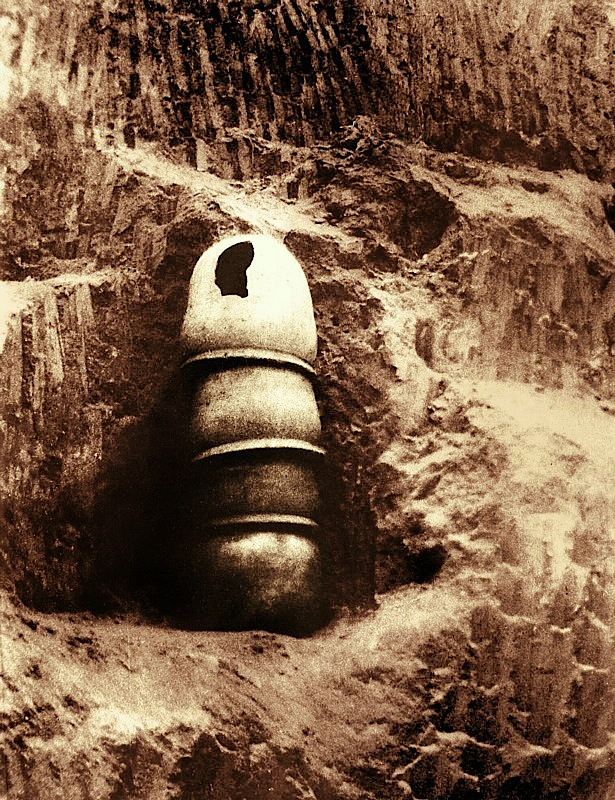
Exquisite bioelectrical knowledge possessed by the Ohum Paleolithic culture over 13,000 years ago is revealed by the exotic pyromagnetic mineral content of their gigantic earthenware vessels that exactly matches the metallic composition of the synthetic stonework of their magnificent pyramid complexes.
Archeological excavations conducted near Quevedo, Ecuador by Julio Viteri Gamboa and Olaf Holm from 1968-1976 show Ohum megaceramic burial urns in situ, often stacked vertically within the tumuli (above), at sites with linear alignments of large circular burial mounds they estimated to be >8,000 years in age.
The same comprehensive and irrefutable petrological analyses that established the semiconductor properties of Atlantean firestone comprising the La Maná pyramid complex have revealed the identical semiconductor composition of Ohum earthenware, activated by roaring infrasound over 13,000 years ago.
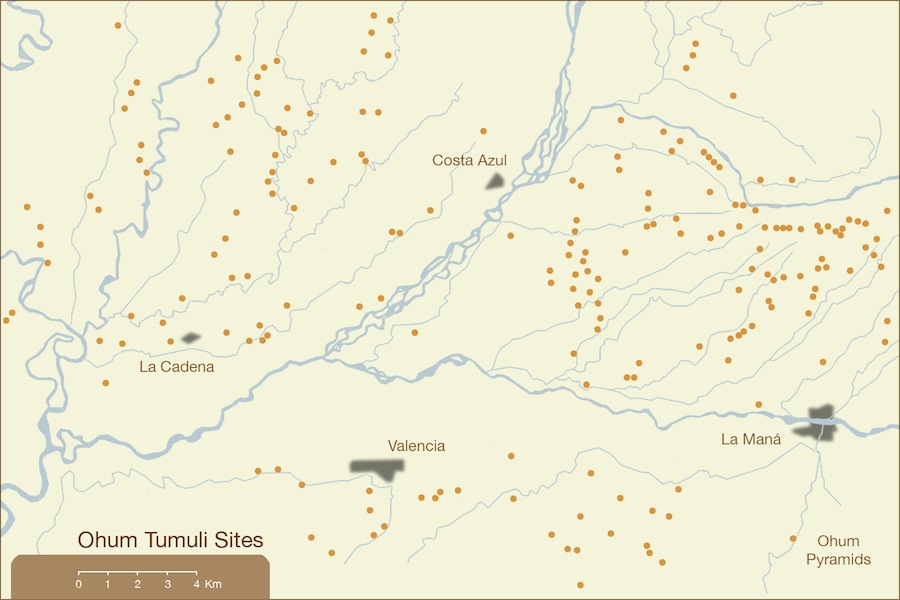
The sophistication and sheer immensity of the Ohum pyramid complex of On and the great abundance of associated earthen tumuli and megaceramic remains discovered throughout the entire region indicates an extremely prolonged period of widespread high-tech Paleo-Sanskrit cultural activity. Recent surveys of the dense clusters of tumuli situated in the vicinity of the La Maná pyramids have identified hundreds of habitation sites (above), with each site encompassing dozens of tumuli (Guillaume-Gentil, 2010).
Each of the tens of thousands of tumuli contains several megaceramic jars. A small group are displayed in a local archeology museum in Quevedo, yet most of the megaceramic jars excavated by archeologists decades ago have since disappeared into vaults at the Smithsonian Institute and the Bank of Ecuador.
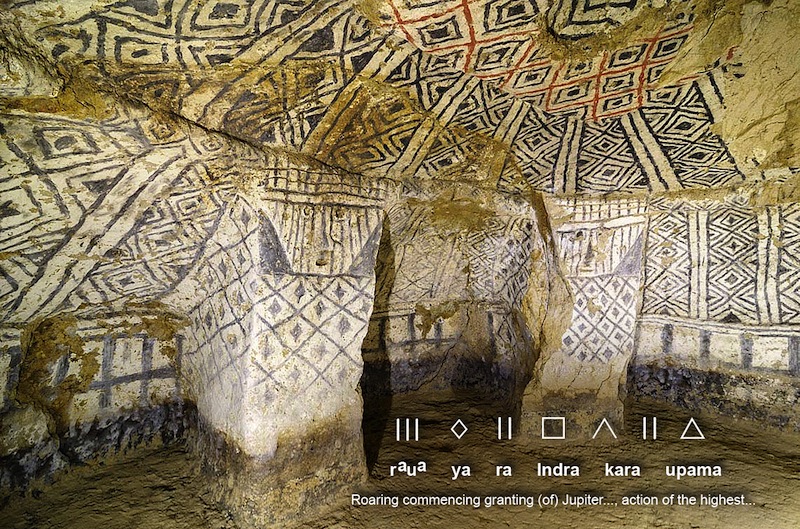
Simpler earthenware jars without semiconductor inclusions were recovered in subterranean chambers at Tierradentro and at hundreds of other ancient sites near San Agustin, Colombia. Spectacular hewn stone staircases spiral down into resonant volcanic tuff bedrock, forming recessed entrances to the many small hypogea. The chambers' whitewashed interior walls are completely covered in hypnotic symmetrical linear patterns painted in red ochre and charcoal representing Paleo-Sanskrit votive texts.
Well preserved geometric murals provide simple hieroglyphic phrases praising bioelectrical benefits granted by the infrasonic resonance of Jupiter, as focused by the Great Pyramid, repeating the phrase: raua ya ra Indra kara upama , meaning "Roaring commencing granting (of) Jupiter..., action (of) the highest..." (above).
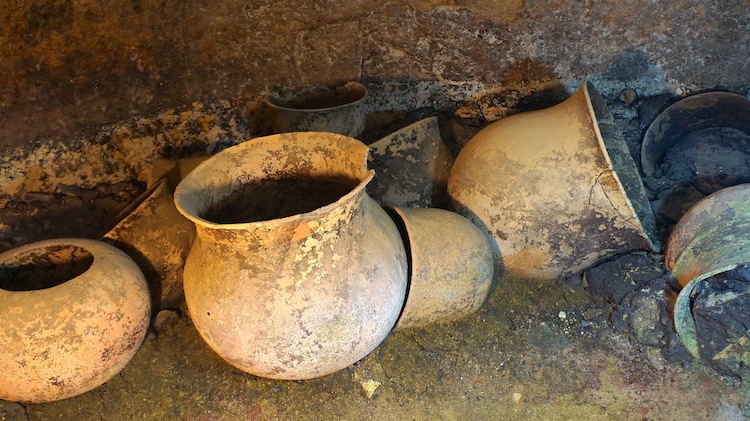
Thin-walled chicha fermentation pots and large burial urns have been excavated from hypogea and tumulus formations in San Agustin, Colombia. A repeating band of Paleo-Sanskrit hieroglyphs is roughly circumscribed around the shoulder of the domed lid, reading: raua ta ra raua ta ra : : : : : : , meaning "Roaring endowing granting, roaring endowing granting... (of) the two, the two, the two..." (below).
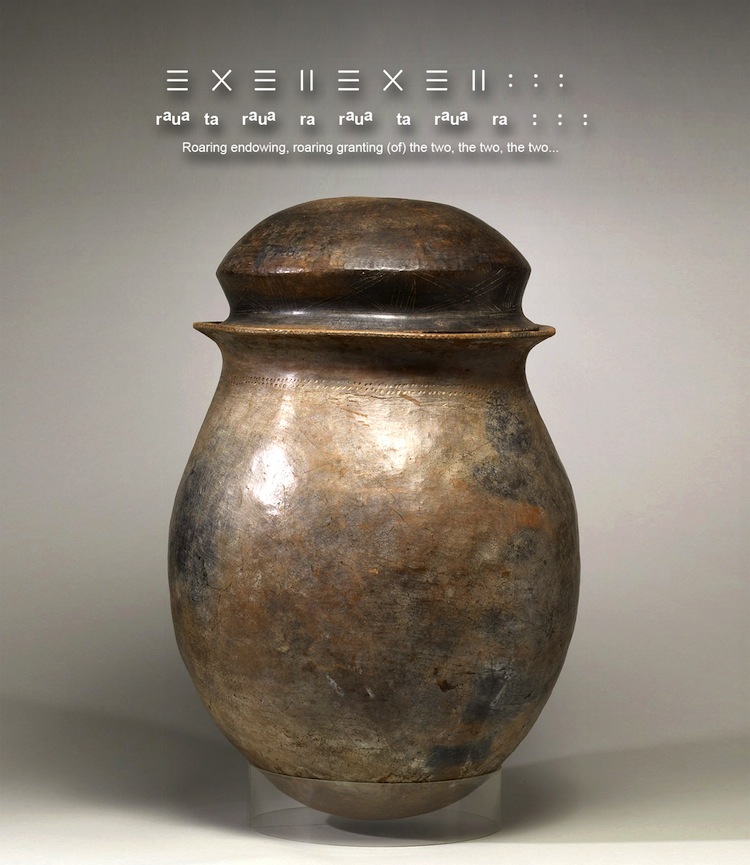
The San Agustin jars are burnished blackware produced using a lye-based glaze, made from wood ash, that lack the great thickness and weight of the more ancient Ohum megaceramics, as well as their special pyromagnetic mineral inclusions. Accurate radiocarbon dates for large urns such as these have been systematically suppressed by academia, for they were actually produced ~11,000--9,000bp, through the cultural recovery period following tectonic destruction of the great Ohum cities 12,890 years ago.
The near perfection of the egg-like geometric form of Ohum fermentation jars is only matched today by the master potters of Korea who have maintained ancient traditional techniques of onggi fermentation vessels from their Neolithic Jomon ancestors. Traditional onggi pottery glaze requires firing temperatures of ~1,100°C and consists of a thin slurry of water, wood ash and leaf mold easily obtained during autumn.
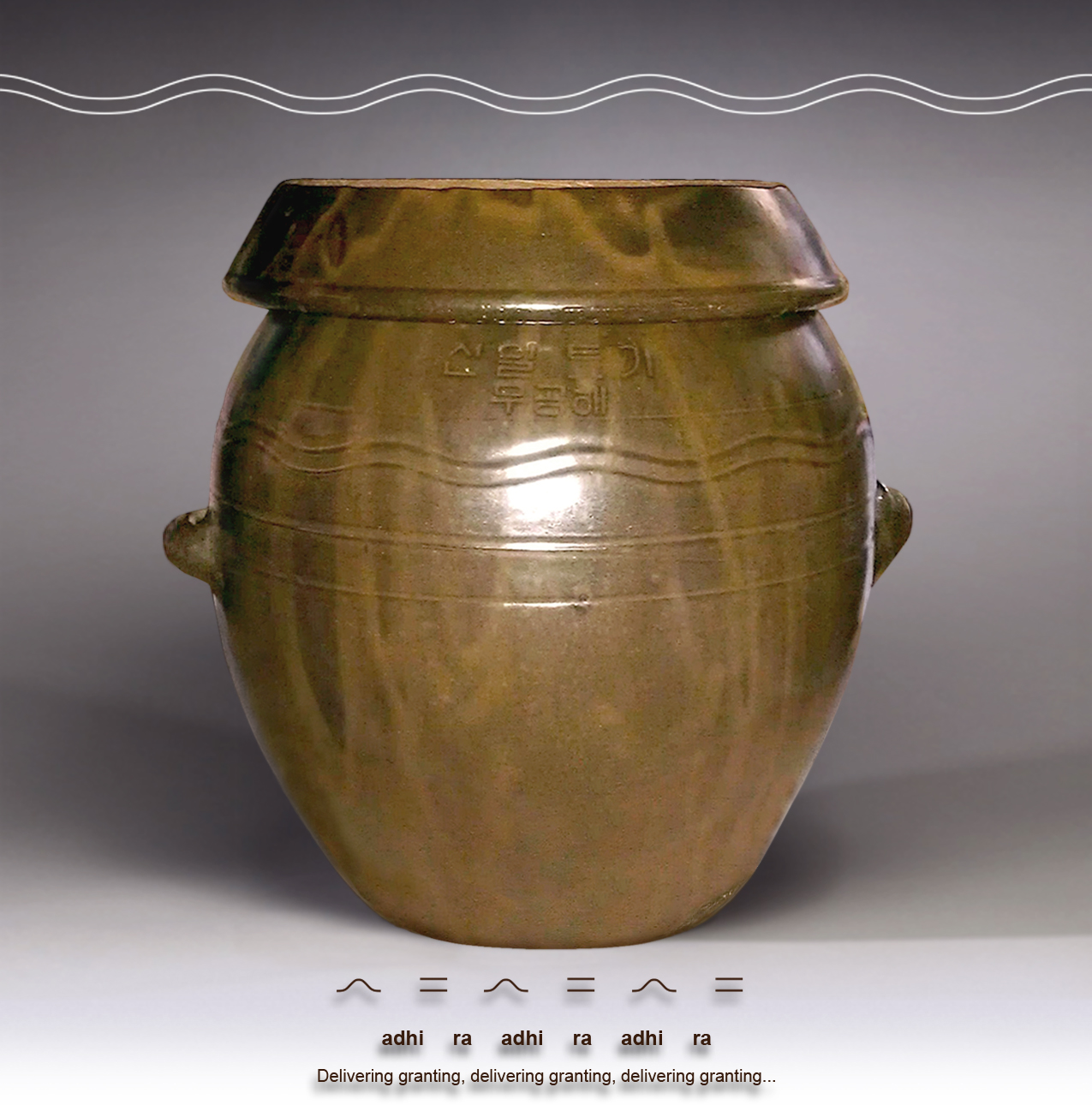
The Paleolithic origin of onggi-making stretches much farther back in time that previously suspected. Ancient hieroglyphic ligatures of the Paleo-Sanskrit language are still applied by Korean onggi potters to this day. Paired wavy lines circumscribing onggi vessels signify the votive phrase: adhi ra adhi ra adhi ra , meaning "delivering granting, delivering granting..." (above). These ligature patterns also adorn the unglazed earthenwares of the Ohum culture of Ecuador, providing decisive confirmation that the onggi fabrication technique was inherited through direct lines of cultural transmission from the high-tech Paleo-Sanskrit civilization that thrived throughout the entire world during the extended time period from ~30,000--13,000 years ago.
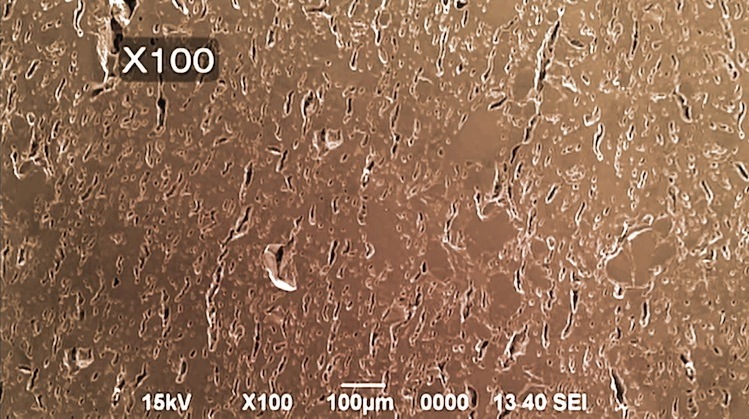
Scanning electron microscopy of a cross-section of an onggi vessel under 100x magnification shows fine networks of micropores weaving throughout the earthenware that are not present in conventional ceramics (above). The interconnecting pores are further revealed at 500x magnification, endowing onggi with high gas permeability, allowing diffusion of fermentation gases while remaining impermeable to water (below).
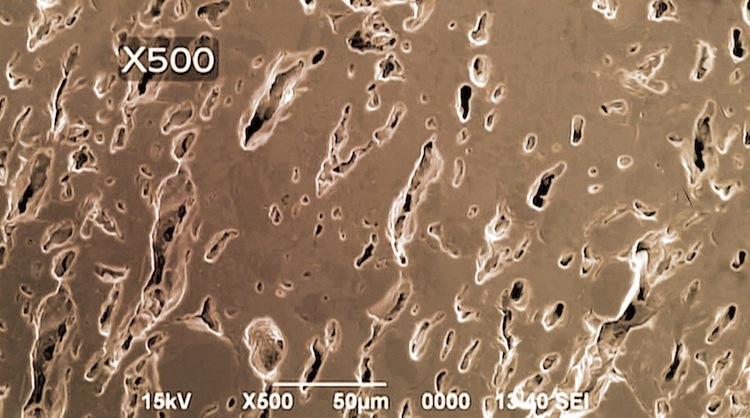
The unique porosity of modern Korean onggi is achieved by working firm clay with a high sand content. This special feature allows adequate ventilation for maintaining the freshness of fermenting food stores, an action traditionally referred to as 'onggi drawing breath' (illustrated below). When stored in areas with optimal conditions for maximizing sunlight and fresh air, onggi earthenware enables fermentation periods exceeding 10 years. The addition of sand also enhances the piezoelectric properties of the huge jars, for conducting electrical ground currents that effectively eliminate pathogenic microbes from their surfaces.
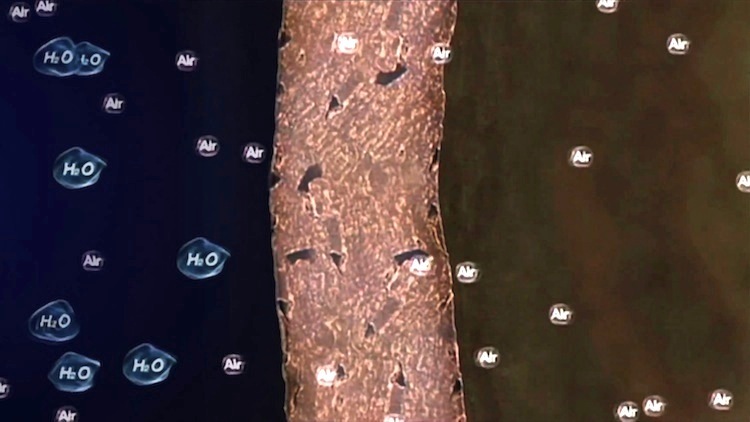
The very similar earthenware produced by the Paleolithic Ohum culture of present-day Ecuador and Peru were mixed with specially formulated combinations of fine quartz sand, tourmaline, magnetite, pyrite, iron, nickel and laterite. These inclusions give Ohum earthenware piezoelectric, pyroelectric, ferromagnetic and paramagnetic properties for transducing focused infrasound at the pyramids into electrical currents that sterilize the vessels and their contents. The Ohum also interred their dead in megaceramic funerary urns for electromagnetic preservation of the body and associated offerings deep within earthen tumuli.
When Ohum earthenware sherds from the La Maná area are submerged in water for cleaning, many fine streams of air bubbles are released, slowly escaping the fine networks of micropores. Many thousands of years of weathering in surface soils has further enhanced their very high porosity.
Laboratory testing of the antifungal (anticancer) effect of traditional Korean foods fermented in different types of conventional containers have shown the superiority of the ancient onggi vessel's porous design. Comparison of doenjang, a staple Korean fermented bean paste product, stored for 4 weeks at 37°C in onggi, ceramic, stainless steel, and glass containers showed onggi earthenware maximizes the alkalizing and anticancer effects of the process (results graphed below, shown with napa cabbage).
Professor Park Geon-yeong of Pusan National University summarizes the extremely beneficial saline probiotic chemistry that develops during the fermentation process under optimal conditions:
In the fermentation process, protein splits into peptides and creates many anticarcinogens. There is a component called genistein. When fermented, genistein becomes agylcone, which is a strong anticarcinogen.
The elevated probiotic component of fermented foods also promotes the rebalancing of microbial colonies in the human gut, affecting a gradual restoration by replenishing and diversifying the intestinal biome that supports a healthy immune system. Modern reliance on refrigeration has replaced ancient fermentation techniques, facilitating the sharp rise in cancers and autoimmune disorders seen in today's toxic cities --radiating microwave frequencies that stimulate the growth of pathogenic microbes and fungi.
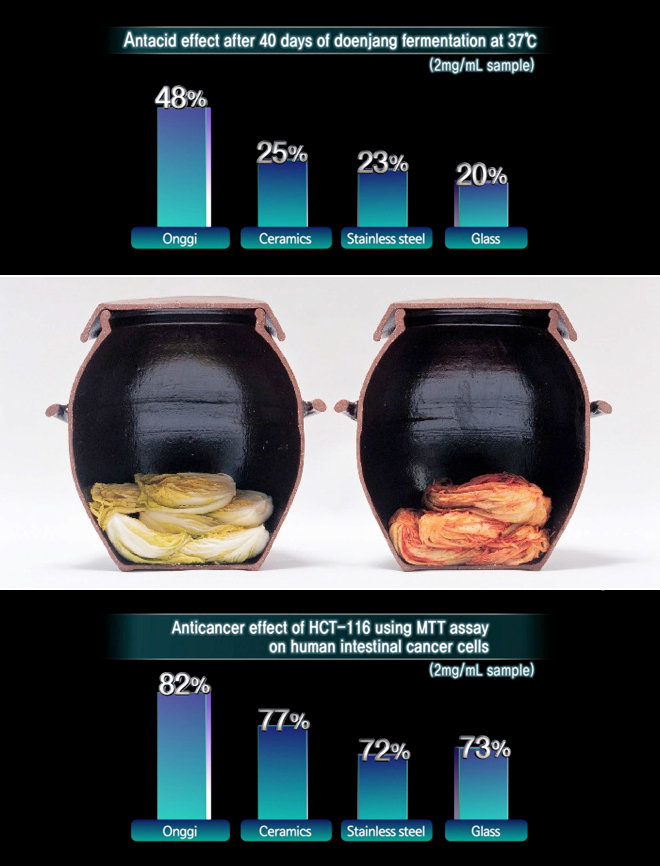
Continue to The Ark of Noah
Return to Magnetic Earthenware
From the book Magnetic Center
Copyright 2015 Alexander Putney